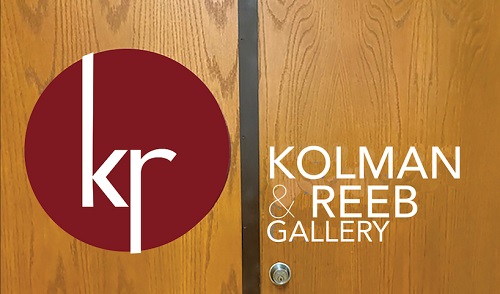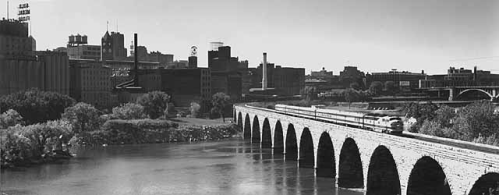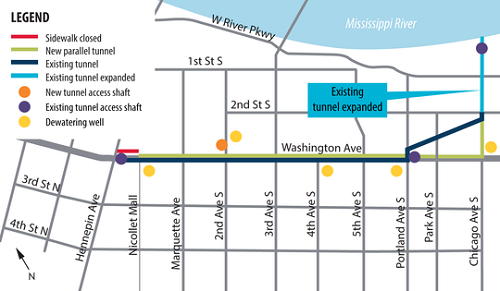Article by Michael Rainville, Jr.
A few weeks back, the United States Senate passed an act that may impact our everyday lives come wintertime, so hold your clocks up to a mirror, because it’s time to reflect on Daylight Saving Time in the Twin Cities.
This past March 13th, we switched to Daylight Saving Time (DST), a tradition that has been around since 1966. While adjusting our clocks twice a year is an easy task, it wasn’t always this way. As the world became more global, coordinating transportation, meetings, events, etc., became increasingly more difficult as most towns followed local solar time, meaning noon was when the sun was at its highest point in the sky. Locally, this confusion reached its tipping point in 1965 when Minneapolis and Saint Paul followed separate times.
In order to get a better understanding of the 1965 debacle, let’s start with the origins of Standard Time.
 WWI poster used as a reminder to end DST come October 27th, 1918As railroads grew and expanded across the United States in the later half of the 1800s, it became a nightmare to coordinate arrival and departure times since there were over 300 different times at the many railroad stations across the nation. At first, railroad managers implemented 100 time zones in the United States, but that quickly proved to be ineffective. In the 1880s, railroad companies took note of Cleveland Abbe, a meteorologist, who assigned four time zones to his various weather stations across the nation. Once the planning of creating four time zones for railroads to use was complete, Standard Time with four zones became official at noon on November 18th, 1883, in Chicago, Illinois.
WWI poster used as a reminder to end DST come October 27th, 1918As railroads grew and expanded across the United States in the later half of the 1800s, it became a nightmare to coordinate arrival and departure times since there were over 300 different times at the many railroad stations across the nation. At first, railroad managers implemented 100 time zones in the United States, but that quickly proved to be ineffective. In the 1880s, railroad companies took note of Cleveland Abbe, a meteorologist, who assigned four time zones to his various weather stations across the nation. Once the planning of creating four time zones for railroads to use was complete, Standard Time with four zones became official at noon on November 18th, 1883, in Chicago, Illinois.
Standard Time and the four time zones were predominantly used by railroads and cross-country business affairs up until World War I. During the war, Germany created Daylight Saving Time in order to save fuel, with Britain following suit. The United States, too, implemented DST on March 31st, 1918, which also meant the four time zones were federally recognized. With backlash from farmers, DST was dropped once WWI ended. However, it was still an option on a more local level. One of the main metropolitan areas to still use DST was New York City, and since that city was so influential in the financial sector, many large cities also used DST including Minneapolis, home of the Grain Exchange.
 A local conductor and engineer synchronizing their watches for the start of "War Time" during WWII
A local conductor and engineer synchronizing their watches for the start of "War Time" during WWII
The federal government would once again institute DST during WWII, this time calling it “War Time,” and made it an option for local municipalities to use once the war was over. With no federal regulations regarding DST, confusion was plentiful.
In 1957, Minnesota passed a statewide DST act much to the chagrin of the farmers. DST was used between Memorial Day and Labor Day, the shortest timeframe in the nation, and counties were allowed to set their own DST. However, a group of drive-in movie theater owners successfully sued the state and counties were no longer able to set their own DST. This also caused confusion on a regional level as North Dakota did not use DST and Wisconsin did, but between April and October.
 May 2, 1965 Pioneer Press cartoon
May 2, 1965 Pioneer Press cartoon
In 1965, everything came to a boil when towns in the western section of the state, like Breckenridge and Moorhead, opted to stay on Standard Time while towns in the east, like Duluth and Winona started DST in April along with Wisconsin. This caused a chain reaction of towns either switching to DST before the state allowed it, or not switching to DST at all.
Saint Paul would soon jump on the bandwagon of having an earlier DST starting date when their city council voted to switch to DST on May 4th, roughly two weeks before the rest of the state would. This greatly angered Governor Karl Rolvaag, the state legislature, and Mayor Arthur Naftalin of Minneapolis. Not every organization in Saint Paul switched to DST on May 4th either. The fire department did, but the police did not as it was against state law. The Ramsey County Board scheduled meetings using Standard Time, but the Saint Paul council chambers where they met had clocks set to DST. At the Minneapolis-Saint Paul International Airport, Northwest Airlines had two clocks at their front desk: one set to Minneapolis time and one to Saint Paul time. Despite there being two weeks of the Twin Cities being an hour apart, there were not many reported problems of employees showing up to work an hour early or an hour late.
The inconsistent implementation of DST throughout the United States was never really a major problem until this debacle in the Twin Cities. Congressmen Don Fraser of Minnesota’s 5th district, and future mayor of Minneapolis, brought legislation to the nation’s capitol that would bring uniformity to DST across the United States. Enacted on April 13th, 1966, and implemented a year later, the Uniform Time Act finally brought the nation together for the first time since WWII. States were allowed to opt out, with only Arizona and Hawaii still choosing to. For those states who chose to follow the Act, DST began at 2:00 A.M. on the last Sunday in April and ended at 2:00 A.M. on the last Sunday in October. The most recent change to this came in 2007 when Congress moved the start day up to the second Sunday in March and the end date pushed back to the first Sunday of November.
 Current time zones in the United States
Current time zones in the United States
This year, the United Stated Senate unanimously voted to pass the Sunshine Protection Act, which would make DST permanent if the House of Representatives also passes it and President Biden signs it into law. If this were to happen, clocks will not be returned to Standard Time come November 5th, 2023.
Switching between Standard Time and Daylight Saving Time has become second nature to us all, but the times may be changing soon, or never again. Will this latest time legislation bring back the century’s old rivalry between Minneapolis and Saint Paul if one city tries to pull a fast one again? Only time will tell.
- - - - - - - - - - - - - - - - - - - - - - - - - - - - - - - - - - - - - - -
 About Michael Rainville, Jr.
About Michael Rainville, Jr.
A 6th generation Minneapolitan, Michael Rainville, Jr. received his B.A. in History, Graduate Certificate in Museum Studies, and M.A. in Art History from the University of St. Thomas.
Michael is a historical interpreter at the Minnesota History Center and has been a lead guide at Mobile Entertainment LLC, giving Segway, walking, and biking tours of the Minneapolis riverfront for 9+ years.
 Thursday, April 14, 2022 at 11:03AM |
Thursday, April 14, 2022 at 11:03AM |  Kim Eslinger |
Kim Eslinger |  Kolman & Reeb Gallery is located in Studio 395, Northrup King Building at 1500 Jackson Street NE, Minneapolis
Kolman & Reeb Gallery is located in Studio 395, Northrup King Building at 1500 Jackson Street NE, Minneapolis Jodi Reeb“Jodi is a perfect partner as we take the gallery forward with our new Project Space Grant Program, continue our popular and critically acclaimed gallery activities and exhibitions, and develop new ways to engage and interact with the public,” Kolman adds. “If you liked us before, you’re going to like us even better now. Jodi and I are energized about the whole enterprise.”
Jodi Reeb“Jodi is a perfect partner as we take the gallery forward with our new Project Space Grant Program, continue our popular and critically acclaimed gallery activities and exhibitions, and develop new ways to engage and interact with the public,” Kolman adds. “If you liked us before, you’re going to like us even better now. Jodi and I are energized about the whole enterprise.”















































